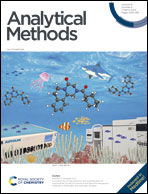A simple photoelectrochemical aptasensor based on MoS2/rGO for aflatoxin B1 detection in grain crops†
Abstract
Designing a simple and sensitive photoelectrochemical (PEC) sensor is crucial to addressing the limitations of routine analytical methods. The sensitivity of the PEC sensor, however, relies on the photoelectric material used. In this manuscript, composites of MoS2/rGO (MG) with a large area and layered structure are prepared by simple steps. This material exhibits sensitivity to visible light and demonstrates outstanding photoelectric conversion performance. The constructed PEC aptasensor using this material to detect aflatoxin B1 (AFB1) shows significantly higher sensitivity and stability compared to similar sensors. This may be attributed to the presence of surface defects in MoS2, which provide more active sites for photocatalysis. Additionally, graphene oxide (GO) is reduced to rGO by thiourea and forms a heterojunction with MoS2, enhancing charge carrier separation and interfacial electron transfer. Our research has revealed that the photocurrent intensity of the aptamer electrode decreases with an increase in AFB1 concentration, resulting in a “signal-off” PEC aptasensor. The detection limit of this aptasensor is 2.18 pg mL−1, with a linear range of 0.001 to 100 ng mL−1. This result will also provide a reference for the study of other mycotoxins in food.



 Please wait while we load your content...
Please wait while we load your content...